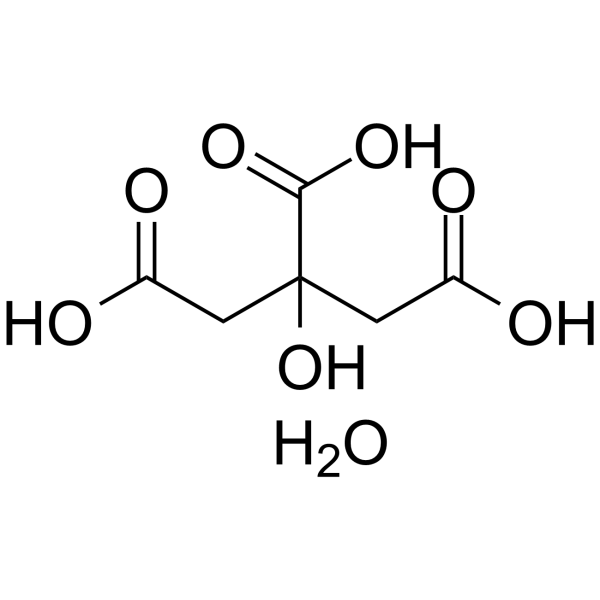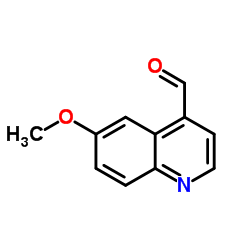Citric acid monohydrate

Citric acid monohydrate structure
|
Common Name | Citric acid monohydrate | ||
|---|---|---|---|---|
| CAS Number | 5949-29-1 | Molecular Weight | 210.139 | |
| Density | 1.54 | Boiling Point | 56 °C760 mm Hg(lit.) | |
| Molecular Formula | C6H10O8 | Melting Point | 135-152 ºC | |
| MSDS | Chinese USA | Flash Point | 173.9 ºC | |
| Symbol |

GHS07 |
Signal Word | Warning | |
Use of Citric acid monohydrateCitric acid monohydrate is a natural preservative and food tartness enhancer. Citric acid monohydrate induces apoptosis and cell cycle arrest at G2/M phase and S phase. Citric acid monohydrate cause oxidative damage of the liver by means of the decrease of antioxidative enzyme activities. Citric acid monohydrate causes renal toxicity in mice[1][2][3]. |
| Name | Citric acid monohydrate |
|---|---|
| Synonym | More Synonyms |
| Description | Citric acid monohydrate is a natural preservative and food tartness enhancer. Citric acid monohydrate induces apoptosis and cell cycle arrest at G2/M phase and S phase. Citric acid monohydrate cause oxidative damage of the liver by means of the decrease of antioxidative enzyme activities. Citric acid monohydrate causes renal toxicity in mice[1][2][3]. |
|---|---|
| Related Catalog | |
| Target |
Human Endogenous Metabolite |
| In Vitro | Citric acid monohydrate (0-12.5 mM; 24 h) shows antiproliferative activity in a dose dependent manner[3]. Citric acid monohydrate (12.5 mM; 72 h) induces apoptosis and cell cycle arrest at G2/M phase and S phase in a dosedependent manner[3]. Citric acid monohydrate (12.5 mM; 48 h) increases the expression of FAS, BAX, BID, AIF, EndoG, cytochrome c, PARP, GADD153, GRP78 and caspase-3, -8, -9, and decreases of BCL-2 and BCL-Xl[3]. Cell Viability Assay[3] Cell Line: HaCaT cells Concentration: 0, 2.5, 5, 7.5, 10, 12.5 mM Incubation Time: 24 h Result: Inhibited the cell viability in a dose dependent manner. Cell Cycle Analysis[3] Cell Line: HaCaT cells Concentration: 12.5 mM Incubation Time: 0, 12, 24, 48, 72 h Result: Induced apoptosis and cell cycle arrest at G2/M phase and S phase in a dosedependent manner. Western Blot Analysis[3] Cell Line: HaCaT cells Concentration: 12.5 mM Incubation Time: 12, 24, 48 h Result: Increased the expression of FAS, BAX, BID, AIF, EndoG, cytochrome c, PARP, GADD153, GRP78 and caspase-3, -8, -9, and decreased of BCL-2 and BCL-Xl. |
| In Vivo | Citric acid monohydrate (120, 240, and 480 mg/kg; i.p.) significantly decreases GSH-Px activity and induces an increase in the MDA (malonyldialdehyde) levels in mouse liver[1]. Citric acid monohydrate (120, 240, and 480 mg/kg; i.p.) induces apoptosis by increases caspase-3 activity in a dose-dependent manner in mouse hepatocytes[1]. Citric acid monohydrate (120, 240, and 480 mg/kg; i.p.; weekly for 3 weeks) causes renal toxicity in mice[2]. Animal Model: 20 g male Kunming mice[2] Dosage: 120, 240, 480 mg/kg Administration: I.p.; weekly for 3 weeks Result: T-SOD and GSH-Px activities in the treated groups decreased with increasing doses of citric acid, NOS activity tended to increase, and H2O2 and MDA contents gradually decreased. |
| References |
| Density | 1.54 |
|---|---|
| Boiling Point | 56 °C760 mm Hg(lit.) |
| Melting Point | 135-152 ºC |
| Molecular Formula | C6H10O8 |
| Molecular Weight | 210.139 |
| Flash Point | 173.9 ºC |
| Exact Mass | 210.037567 |
| PSA | 141.36000 |
| Vapour density | 2 (vs air) |
| Vapour Pressure | 184 mm Hg ( 20 °C) |
| Index of Refraction | n20/D 1.359(lit.) |
| Storage condition | Store at RT. |
| Stability | Stable. Incompatible with oxidizing agents, bases, reducing agents, nitrates. |
| Water Solubility | 1630 g/L (20 ºC) |
CHEMICAL IDENTIFICATION
HEALTH HAZARD DATAACUTE TOXICITY DATA
|
| Symbol |

GHS07 |
|---|---|
| Signal Word | Warning |
| Hazard Statements | H319 |
| Precautionary Statements | P305 + P351 + P338 |
| Personal Protective Equipment | dust mask type N95 (US);Eyeshields;Gloves |
| Hazard Codes | Xi:Irritant |
| Risk Phrases | R36/37/38;R41 |
| Safety Phrases | S9-S16-S26-S37/39-S36/37/39 |
| RIDADR | UN 1090 3/PG 2 |
| WGK Germany | 1 |
| RTECS | AL3150000 |
| Packaging Group | I; II; III |
| HS Code | 2918140000 |
| Precursor 0 | |
|---|---|
| DownStream 9 | |
| HS Code | 2918199090 |
|---|---|
| Summary | 2918199090 other carboxylic acids with alcohol function but without other oxygen function, their anhydrides, halides, peroxides, peroxyacids and their derivatives。Supervision conditions:None。VAT:17.0%。Tax rebate rate:9.0%。MFN tariff:6.5%。General tariff:30.0% |
|
Dietary vitamin D3 deficiency alters intestinal mucosal defense and increases susceptibility to Citrobacter rodentium-induced colitis.
Am. J. Physiol. Gastrointest. Liver Physiol. 309 , G730-42, (2015) Vitamin D deficiency affects more that 1 billion people worldwide. Although thought to increase risk of bacterial infections, the importance of vitamin D on host defense against intestinal bacterial p... |
|
|
Magnetic graphene as modified quick, easy, cheap, effective, rugged and safe adsorbent for the determination of organochlorine pesticide residues in tobacco.
J. Chromatogr. A. 1406 , 1-9, (2015) In this study, magnetic graphene was used as modified quick, easy, cheap, effective, rugged and safe (QuEChERS) adsorbent for the determination of organochlorine pesticide (OCPs) residues in tobacco. ... |
|
|
Development of an enzymatic assay system of D-lactate using D-lactate dehydrogenase and a UV-LED fluorescent spectrometer.
J. Pharm. Biomed. Anal. 116 , 150-5, (2015) In this study, we aimed to develop a new enzymatic assay system of d-lactate with good precision, accuracy, and sensitivity for the determination of D-lactate concentrations in rat serum. D-Lactate de... |
| EXTRAN AP 22 |
| monohydrate citric acid |
| ACETONE D |
| ACETONE 300 |
| Citric acid hydrate |
| citric acid monohydrate powder |
| 1,2,3-Propanetricarboxylic acid, 2-hydroxy-, hydrate (1:1) |
| citric acid hydride |
| MFCD00008765 |
| EINECS 200-662-2 |
| citric |
| 2-Hydroxy-1,2,3-propanetricarboxylic acid hydrate (1:1) |
| ACETONE 5000 |
| 2-Hydroxypropane-1,2,3-tricarboxylic acid hydrate (1:1) |
| ACETONUM |
| 2-Hydroxy-1,2,3-propanetricarboxylic acid hydrate |
| METHYL KETONE |
| FEMA 3326 |
| Citric acid monohydrate |
| PROPANONE |
| Acide 2-hydroxy-1,2,3-propanetricarboxylique hydrate |
![2-hydroxypropane-1,2,3-tricarboxylic acid,1-methyl-2-[2-[4-[3-(trifluoromethyl)phenyl]piperazin-1-yl]ethyl]benzo[e]benzimidazole structure](https://image.chemsrc.com/caspic/082/110545-39-6.png) CAS#:110545-39-6
CAS#:110545-39-6 CAS#:4363-94-4
CAS#:4363-94-4 CAS#:121667-85-4
CAS#:121667-85-4 CAS#:121667-84-3
CAS#:121667-84-3![trimethyl 2,2',2''-(3-hydroxy-6-(hydroxy(5-vinylquinuclidin-2-yl)methyl)-8-methoxy-1-oxo-2,3,5,6-tetrahydro-1H-3a,6-methanobenzo[d]pyrrolo[2,1-b][1,3]oxazepine-3,5,5-triyl)triacetate structure](https://image.chemsrc.com/caspic/298/121667-83-2.png) CAS#:121667-83-2
CAS#:121667-83-2![5-ethenyl-1-azabicyclo[2.2.2]octane-2-carbaldehyde structure](https://image.chemsrc.com/caspic/405/35189-41-4.png) CAS#:35189-41-4
CAS#:35189-41-4 CAS#:96036-02-1
CAS#:96036-02-1![2-[2-[4-(4-chlorophenyl)piperazin-1-yl]ethyl]-1-propan-2-ylbenzo[e]benzimidazole,2-hydroxypropane-1,2,3-tricarboxylic acid structure](https://image.chemsrc.com/caspic/120/110545-38-5.png) CAS#:110545-38-5
CAS#:110545-38-5![2-hydroxypropane-1,2,3-tricarboxylic acid,2-[2-[4-(3-methoxyphenyl)piperazin-1-yl]ethyl]-1-propan-2-ylbenzo[e]benzimidazole structure](https://image.chemsrc.com/caspic/018/80429-41-0.png) CAS#:80429-41-0
CAS#:80429-41-0
